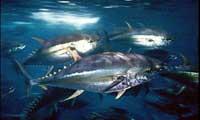You will have to see red, red tuna

Red tuna are large fish - up to 600 kilos-, fast swimmers and strong eaters. Bluefin tuna makes great migrations for both breeding and food. At this time of year, tuna schools are concentrated in the Mediterranean, north and east of the Balearic Islands, which are for them time and place of setting. As a result, industrial fishing boats around the world have an important annual meeting in the waters of the Mediterranean, to the detriment of bluefin tuna.
Due to overfishing, the bluefin tuna population has declined significantly in recent years. According to data from environmental groups, the adult population of bluefin tuna has decreased by 80% in the last 20 years. In a few years there will be no tuna for fishing.
Most of the specimens captured in the Mediterranean are sent to Japan. In January 1998 Japan imported 3,078 tons of fresh tuna by plane, doubling the 1997 figure. In the Japanese market, bluefin tuna is a highly appreciated fish, with a price of 5,600 pesetas per kilo, so in the Mediterranean are concentrated numerous pirate fishing boats that are not part of the International Commission for the Conservation of Tuna. Most pirate longliners that work in the vicinity of the Balearic Islands are industrial, have a length of 55/60 meters, can use longliners 100 kilometers long and more than 2,000 hooks. Along with these illegal boats many other Mediterranean countries, with other fishing techniques, and finally, more and more small boats dedicated to sport fishing. In addition to legal and illegal, the future of bluefin tuna has become black.
Although these boats catch bluefin tuna, many of them are not part of the International Commission for the Conservation of Tuna, so you cannot know how much is caught or whether or not they meet the limits set in this regard. Therefore, the International Commission has adopted a series of measures to address these abuses, such as the ban on the importation of tuna from Belize, Honduras or Panama, but many ships are changing from ikurriña. The United States and Japan itself, members of the Commission, have banned the importation of tuna from ships from several countries, but the reality is that tuna marketing has not been interrupted. Despite the fact that since 1974 scientists predicted the danger of tuna status and recommended fishing less, no one has paid attention to them. Some data provided by Greenpeace are:
- Year 1974: Catches increased from 5,000 to 14,000 t.
- Year 1994: 38,000 tons. In that year, the aforementioned International Commission requested the ban on fishing for longline vessels over 24 meters in length in June and July. He also recommended reducing total catches by 25%.
- Year 1995: The recommendations of the International Commission for the Conservation of Tuna came into force, but no one respected them.
- Year 1996: The International Commission recommended reducing the catch of bluefin tuna by 35%.
- From 1997: A total of 44,000 tonnes of bluefin tuna have been declared annually. The International Commission for the Conservation of Tuna believes that reality is even more serious. Since the aforementioned data do not take into account the catches of pirate ships, the International Commission considers that they can be between 30 and 35% higher. Therefore, the calculations made by scientists, which are very negative, do not predict a beautiful future either.
So far we have talked about figures, but the mode of catches can be more serious than that of high catches. In addition to capturing too many red specimens at the time of setting, too young tuna are also captured. Bluefin tuna reaches sexual maturity at the age of five – when it has about 30 kilos – although by law you can also catch tuna of more than six kilos. In the Mediterranean and the Gulf of Biscay, the capture of tuna of less than six kilograms and a half can represent between 35% and 40% of the total. This means that the market for young tuna is growing and, from a scientific point of view, the future of the species is staggering. Therefore, in view of this year's campaign, the International Commission for the Conservation of Tuna has established a catch share of 32,000 tons. In any case, the aforementioned Commission considers that if the number of catches decreased to 25,000 t, the loss of bluefin tuna would remain unrecovered. So things, it is clear that bluefin tuna will have to see the reds.
Published in 7
Buletina
Bidali zure helbide elektronikoa eta jaso asteroko buletina zure sarrera-ontzian











